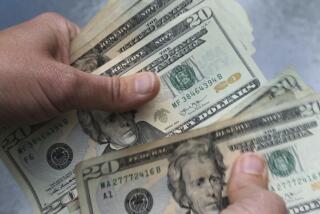Crisis may cure our materialism, shift priorities
- Share via
It’s a stat we hear time and again: Consumer spending accounts for more than two-thirds of the U.S. economy. It was the reason President Bush famously (or infamously) urged Americans shortly after the Sept. 11, 2001, terrorist attacks to keep shopping and “get down to Disney World in Florida.”
Take that, Osama!
“Our whole economy is designed to convince people that they want more,” said David Colander, an economics professor at Middlebury College in Vermont. “Nobody is asking the big question: How much of a consumer society do we really want to be?”
Since the end of World War II, consumer spending has consistently represented more than 60% of U.S. gross domestic product, according to the Commerce Department. The percentage reached 70% in 2002 and is now almost 71%.
U.S. retail sales fell in September for the third straight month -- the first time this has happened since the government started tracking such data in 1992. The holiday shopping season is expected to be the worst in years. But some forecasters are predicting that spending will pick up by the middle of next year as consumers shake off the recession blues.
Colander said Americans’ buy-buy-buy mentality wouldn’t be troubling if it were accompanied by a higher savings rate and lower borrowing. But that’s not the case.
We set aside precious little -- the savings rate is now almost 3% after sticking close to 1% for the last three years -- and we’re carrying nearly $2.6 trillion in nonmortgage consumer debt.
Meanwhile, much of what we buy comes from other countries, while those nations tend not to buy as much of our stuff. The U.S. trade deficit topped $700 billion last year.
This means the U.S. economy relies more heavily on domestic consumption than do export-oriented economies. So when American consumers tighten their belts, the home front gets slammed.
In Europe, consumer spending accounts for about 60% of economic activity, according to the United Nations. In Japan, it’s closer to 55%. And in mega-exporter China, it’s around 35%.
A greater proportion of economic activity in those parts of the world comes from investment in factories and other big-ticket splurges, as well as government expenditures. That doesn’t make these economies fireproof. But it can give them an increased measure of flexibility when times are tough, at least for the short haul. Longer term, their reliance on U.S. consumers’ love of shopping makes them vulnerable to our spending reductions.
Lee Ohanian, an economics professor at UCLA, said there was nothing inherently wrong with consumer spending accounting for almost three-quarters of the economy.
“Every economy is the same,” he said. “Whether you have a little economic activity or a lot, ultimately it all comes down to consumers. The U.S. is by far the most stable economy in the world, and a big reason for that is consumer spending.”
If you believe that such high levels of consumption will continue -- thus creating wealth for companies and shareholders, and fueling economic expansion -- then you’re probably not losing any sleep about the nation’s financial health.
On the other hand, if you believe that such high levels of consumption are unsustainable, and that sooner or later the American people won’t want more stuff, or won’t be able to afford it, where does that leave us?
“That’s the big question,” said Meghan O’Brien, an economist at Iowa State University who focuses on consumer behavior. “It’s in our culture to spend a lot, and it has been for a long time. It would be a significant change if Americans suddenly decided all that spending was bad.”
Such a cultural shift would entail a wholesale reinvention of how we do business, and would almost certainly result in numerous companies either cutting back or folding. Millions of people could be thrown out of work.
“It would be like a perfect storm for the retail industry,” O’Brien said.
A more likely scenario, she said, is a gradual shift of values, with Americans putting greater emphasis on “green” products and businesses, and on no longer spending what we don’t have. This transition would favor companies that make things people genuinely need as opposed to what people want. It would entail a newfound emphasis on long-term satisfaction rather than instant gratification.
“Can a green economy be America’s next driving force?” O’Brien asked. “The potential is there, but it requires a complete change in how we look at money.”
The greening of the U.S. economy won’t happen any time soon, and not ever if the private sector has anything to say about it. Businesses have a lot invested in our chronic materialism.
Maybe they should embrace the current slump as an opportunity for strengthening the country’s long-term health rather than a short-term hit to their bottom lines.
“We need to get the percentage lower,” said Colander of Middlebury College. “Consumer spending shouldn’t be this much of the economy. But it won’t be easy. It will be like an addict going through withdrawal.”
Many addicts embarking on recovery programs begin with the Serenity Prayer: “God, grant me the serenity to accept the things I cannot change, courage to change the things I can, and the wisdom to know the difference.”
Next time you’re at the mall, maybe you could give it a try.
--
David Lazarus’ column runs Wednesdays and Sundays. Send your tips or feedback to david.lazarus@latimes.com.
More to Read
Inside the business of entertainment
The Wide Shot brings you news, analysis and insights on everything from streaming wars to production — and what it all means for the future.
You may occasionally receive promotional content from the Los Angeles Times.











